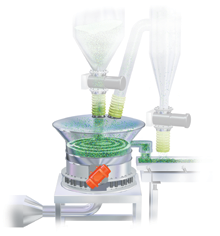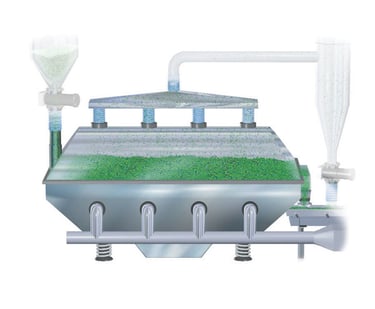In an eNewsletter article for Powder and Bulk Engineering, we explained the advantages of circular fluid bed dryers and coolers versus those that are rectangular in shape.
Vibratory fluid bed dryers and coolers are gaining popularity in a large number of applications thanks to their rapid drying times and suitability for heat-sensitive products. Fluid bed dryers/coolers offer batch and continuous processing capabilities, allowing high throughput for drying and heating applications. In this article, we discuss the differences between circular and rectangular fluid bed dryers, as well as a number of considerations when choosing between circular or rectangular designs.
What goes around comes around
In surveying the different types of vibratory fluid bed dryers and coolers, the circular models stand out as the preferred choice thanks to the following features:
- More consistent heating throughout the fluid bed
- Continuous internal back mixing for drying more sluggish/hard to fluidize materials
- Smaller footprint per volume processed
- Spiral motion with no corners eliminates clumping and accelerates drying of material
- Easier and faster cleaning and inspection with a Quick-Clean sanitary design
- Compliance with stringent standards including 3-A, USDA, FDA and BISCC
- Rapid installation and transportability
- Lower installation and operational costs
- Reduced power consumption
- Relatively low noise
- Explosion protection option

Circular vibratory fluid bed drying and cooling systems are available in a range of sizes, from 18-84 inches (450-2540 mm) in diameter. For processors, this translates to a great range of flexibility when it comes to both small batches and large continuous throughput applications. Materials processed with a circular vibratory fluid bed move in a spiral motion, providing even airflow and vibration throughout the bed to separate and fluidize individual particles. The spiral motion maximizes material surface area and drying.
By virtue of design, circular vibratory fluid beds are free of any internal corners or edges, eliminating those hard-to-clean areas where material could potentially accumulate. Additionally, a circular configuration allows for precise control of air temperature, airflow, bed depth, dwell time and material flow paths on a first-in/first-out basis. The circular design also has the benefit of built-in internal back-mixing of product so that wetter, sloppier feed materials are dried more consistently and with a lower heat history. This renders a more homogeneous material while also keeping the machine cleaner and easier to maintain in the long run.
Inherent strength is another benefit of the circular vibratory fluid bed processor. Its design eliminates the need for heavy-gauge walls and cross braces otherwise required to withstand continuous vibration. This means materials of construction can be down-gauged, vibratory motors can be downsized, and associated components can be eliminated. Circular units also require only one air inlet and outlet and have fewer weld seams compared to rectangular models, reducing overall size and construction costs— especially when finished to 3-A, USDA, FDA, BISCC, and other such stringent sanitary standards. Circular vibratory fluid bed dryers offer significant cost savings, including lower installation costs and multi-purposing capabilities. Energy savings are also significant for circular fluid beds, which consume 20 to 50 percent less power on average than rectangular models for the same throughput and moisture content. Additional cost savings are found in the deeper beds for circular models, which can increase throughput per square foot of factory floor space.
Faster and easier sanitation also reduces costs and downtime. Rectangular dryers/coolers can take several hours to clean, while most circular fluid bed dryers/coolers can be cleaned in under an hour. For food and pharmaceutical applications, quick and efficient sanitation can make a huge difference both in terms of costs and in terms of consumer safety and quality assurance. Another important safety feature for some production lines is the explosion-proof design of the circular fluid bed dryer/cooler. The strength of the circular design minimizes the amount of explosion protection required. Manufacturers should have their product tested for explosive characteristics.
Finally, circular vibratory bed dryers and coolers are much quieter, courtesy of vibration reduction mechanisms. While the blowers make some noise, it is typically only up to 85 decibels. Sounds at 70 decibels and below are considered to be safe, while noise levels of 85 decibels and above, over time, may result in hearing loss. If noise levels are a concern for your facilities, some manufacturers provide noise-reducing silencers as an optional feature to bring the noise levels down to the level required.
Configurable high throughput
 In general, rectangular vibratory fluid bed dryers/coolers are suitable for high-capacity applications and where sanitary and quick-clean features are not a concern. Most rectangular fluid bed dryer and cooler units can be configured to any size, and large conveyors can provide very high throughput for fluid beds. If you have a very high-throughput application and have a lot of floor space for a fluid bed dryer/cooler, then a rectangular model might be a good fit.
In general, rectangular vibratory fluid bed dryers/coolers are suitable for high-capacity applications and where sanitary and quick-clean features are not a concern. Most rectangular fluid bed dryer and cooler units can be configured to any size, and large conveyors can provide very high throughput for fluid beds. If you have a very high-throughput application and have a lot of floor space for a fluid bed dryer/cooler, then a rectangular model might be a good fit.
This option is only practical for larger-scale industrial applications, and it is only useful if you have shifts that provide ample downtime for sanitizing. Cleaning rectangular units also requires a certain degree of expertise, as maintenance staff must open and dismantle covers and get into the dryers/coolers to clean them. If your production line has shifts that can accommodate a more extensive sanitation routine, or if there are no major sanitary requirements to take into consideration for your specific application, then a rectangular unit may be appropriate. In applications where an easier-to-clean circular dryer/cooler can handle the capacity, you should adopt a circular configuration to save on long-term overhead expenses related to the routine maintenance of your unit.
Rectangular fluid bed dryers/coolers also require extensive rigging to stabilize the machine because of the high-intensity vibrations. In contrast, most circular vibratory fluid bed dryers/coolers are equipped with internal vibration cancellation technologies and do not need to be mounted to walls and floors to remain stable in place.
Furthermore, circular units do not require a complex installation process as their rectangular counterparts. Thanks to their configuration, entire fluid bed systems (including heaters/coolers/moisturizers, blowers, and dust collectors) can be self-contained and skid-mounted on common frames with casters, ready to plug in and run (plug-and-go). This offers pilot plants fast setup, compactness, mobility and flexibility—features that cannot be accomplished through rectangular units that are two to three times larger and heavier at equivalent capacities.
Conclusion
When sourcing a vibratory fluid bed dryer or cooler, a circular model should be considered for its consistent and efficient drying results, quick-clean sanitary design, smaller footprint, lower initial and operating costs, and reduced downtime. Rectangular options are appropriate in high-volume continuous applications where there is plenty of floor space and the need for pristine sanitation is not highly prioritized. Today’s circular vibratory fluid bed dryers/coolers are available from small-batch, pilot plant/lab sizes to larger models suitable for continuous processing applications, offering a wide range of options suitable for most applications.
To learn more about fluid bed dryers/coolers download the Fluid Bed Dryers, Coolers and Moisturizers Catalog today or contact our fluid bed technical specialists at info@kason.com or by calling 973-467-8140.

